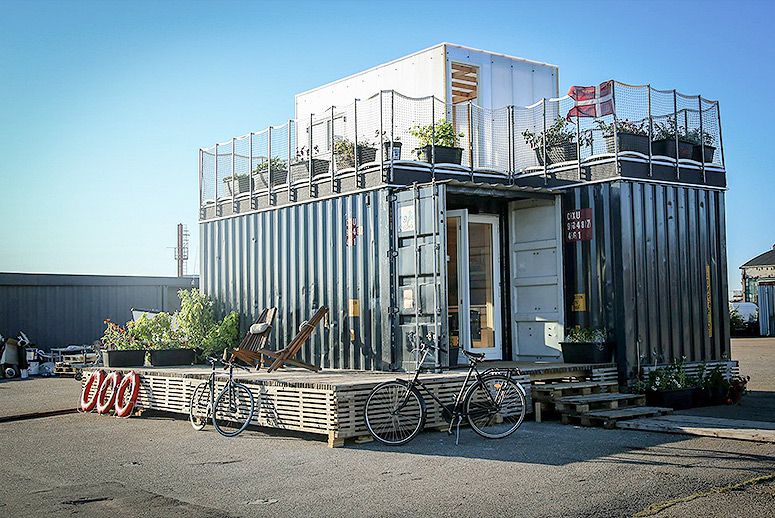HOW A SHIPPING CONTAINER COULD BE YOUR NEXT APARTMENT
 With hundreds of millions struggling to pay rent, a surprising solution could be as close as the nearest port.
With hundreds of millions struggling to pay rent, a surprising solution could be as close as the nearest port.
The Danish affordable-housing initiative CPH Shelter uses shipping containers for cost-effective, energy-efficient housing. (Photo: Igor Bezludov via CPH Shelter/Facebook
Even in the happiest nation on earth, students struggle to find housing that accommodates their budget. Now, one architect and his team believe they’ve hit upon a simple solution for young residents of Copenhagen, Denmark: a village made from upcycled shipping containers.
“In Denmark, there’s a lack of 20,000 student homes,” Michael Plesner, cofounder and partner at CPH Containers, told TakePart. “If scaled up, container villages can actually help push down the price on the general housing markets of cities, which would benefit everyone.”
Advertisement
Around the world, some 330 million urban households face housing insecurity, according to international business consultants McKinsey & Company. Rents are exploding in dozens of cities, and many people are forced to cut back on essentials like health care as a result of paying high prices for substandard housing. Replacing all the inadequate homes by 2025 would cost $9 trillion to $11 trillion. But what if there was a cheaper solution that’s eco-friendly too?
Millions of shipping containers pass through U.S port cities every year, carrying everything from children’s toys to car parts. Made from either steel or aluminum, the boxes are sturdy, designed to be both mobile and modular. A new 8-by-20-foot model goes for around $2,000, a 40-foot-long version is about $3,500, and used models are usually around $1,000 and up. About 1,000 unused shipping containers are available for purchase in the U.S. alone, according to Barry Naef, director of the Intermodal Steel Building Units Association.
Repurposing shipping containers for housing requires cutting out windows and setting up proper waste, energy, and water systems, as with a regular housing unit. Still, Naef told TakePart, “Whether you’re building your home in California or Texas, it’s about 20- to 30-percent cheaper to use a container module” than traditional materials.
While the idea of living in a steel box doesn’t appeal to everyone, eco-conscious architects and designers are jumping on the idea.
Netherlands-based architectural firm Tempohousing has been using shipping containers to create livable units for more than 10 years. To combat the lack of student housing in Diemen, a town bordering Amsterdam, the company constructed a five-story dorm. In Denmark, the architects designed a housing center for those with mental health problems who couldn’t be housed through the regular system. The project is reportedly expanding into Holland.
Plesner’s firm is in the process of creating the first portable container village in Denmark. Architects hope to use unoccupied land in Copenhagen for students who have a tough time finding affordable places to live. The tiny homes are made from all-recycled materials and run on eco-friendly energy and water-waste systems. The firm is working with the city to amend zoning laws to allow such housing spaces and to get building permits.
CPH’s container apartments use sustainable and renewable materials. (Photo: Lauritz.com via CPH Shelter/Facebook)
But even with its proven potential, shipping-container housing continues to be a sore subject for local governments, especially in the U.S. Though cities across the nation face affordable housing shortages—and, partly as a result, a homelessness crisis—a number of barriers stand in the way of building shipping-container homes.
Advertisement
The U.S. Department of Housing and Urban Development requires a unit to be at least 40 feet in length to meet living standards, though city agencies are able to amend the rules. “Houston and Dallas are more advanced for codes,” Anya Bartay, president of construction management firm StudioX9, told TakePart. “Those who do shipping-container housing don’t have to cover it all up.”
Bartay and her team are now building single-family homes out of shipping containers in San Antonio. The houses constructed through the initiative, known as Project Noah, take about three months to complete and sell for around $50,000. “Shipping containers are going to be a necessity as people segue out of apartments and into homes,” said Bartay.
“You see these stories in New York, where people are getting apartments that are only 200 square feet,” Naef said. “I don’t think anyone who needs a place to live is going to complain if there’s a well-done container.”
CPH containers were designed as student housing units to address the lack of affordable housing for college students in Copenhagen. (Photo: Lauritz.com via CPH Shelter/Facebook)







More pictures would have been nice. What a fantastic idea! And the home is impervious to natural disasters to boot!